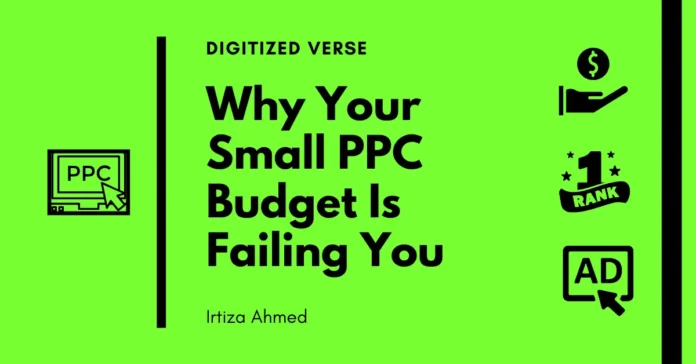Pay-per-click (PPC) advertising is one of the most powerful tools in digital marketing. It offers instant visibility, real-time metrics, and control over targeting that few channels can match. But one of the biggest stumbling blocks for companies investing in PPC is setting the right budget. Too often, businesses pour in a few hundred dollars, hoping for a flood of leads—only to be left frustrated and disappointed.
In this article, we’ll explore why small PPC budgets often fail, what happens when you don’t invest enough, and how to determine a realistic and effective PPC budget based on your industry, goals, and competition.
1. What Is a PPC Budget and Why Does It Matter?
Your PPC budget is the total amount you’re willing to spend on your paid advertising campaigns over a given period. Whether it’s $500 or $5,000, this budget controls the scope, reach, and potential outcomes of your ad campaign.
Think of it like fuel for a car—the more fuel, the farther you can go. A small budget might get you moving, but it won’t take you very far. And in competitive markets, you might not even leave the driveway.
2. The Illusion of Flexibility in PPC Budgets
Yes, PPC platforms like Google Ads or Meta Ads don’t require a minimum budget. Technically, you can start with as little as $1 per day. That flexibility is appealing to startups or small businesses, but it’s also misleading. Just because you can run a campaign with a small budget doesn’t mean you should.
Small budgets limit impressions, clicks, conversions, and data. Worse, they stretch campaigns so thin that you can’t test effectively, optimize performance, or gain actionable insights.
3. Why a $500 PPC Budget Often Fails
Many business owners ask: “Is $500 enough for PPC?” While the intent is good—testing before committing larger sums—this amount often fails to deliver for several reasons:
- Limited ad impressions: Your ads show less frequently.
- Few clicks: Lower budgets can only afford a few clicks per day, especially in competitive industries.
- Insufficient data: Without enough clicks and conversions, platforms can’t optimize effectively.
- Poor optimization cycles: Budget limits can disrupt the learning phase of platforms like Google Ads.
Ultimately, $500 often leads to false conclusions: that PPC doesn’t work, or that the agency/marketer isn’t delivering. But in reality, the campaign never had a fair chance.
4. The Hidden Costs of Underbudgeting
Low-budget PPC campaigns don’t just underperform—they can actually hurt your long-term strategy.
- Wasted time and effort trying to optimize something that lacks potential
- Inaccurate performance data that can misguide future decisions
- Frustration and blame placed unfairly on marketing teams or platforms
- Opportunity costs from choosing a channel that didn’t have enough fuel to run
5. The Economics of a Healthy PPC Budget
So, how much should you spend? The answer depends on your:
- Industry competitiveness
- Cost-per-click (CPC) for your keywords
- Sales cycle and customer value
- Conversion rate goals
For example, if the average CPC in your niche is $5 and you want 100 clicks, you’ll need at least $500. But clicks aren’t conversions—if your conversion rate is 5%, you’d get 5 leads. Is that worth the cost?
A healthy budget ensures enough data, optimizations, and volume to evaluate performance and make improvements.
6. What Happens When You Increase the Budget?
Adding more budget doesn’t guarantee success, but it enables success by giving the campaign breathing room to:
- Reach more people
- Split-test multiple ad creatives
- Optimize based on data
- Generate consistent leads/sales
When businesses invest $2000+ into PPC instead of $500, they often:
- See better ROAS (Return on Ad Spend)
- Experience faster learning and optimization
- Identify top-performing keywords/ad groups faster
- Have clearer insights on what works (and what doesn’t)
7. How to Set a Realistic PPC Budget
To determine a working budget:
- Research average CPC in your industry
- Define your conversion goals
- Multiply clicks needed by CPC
- Factor in testing and learning phase
- Allocate enough to run the campaign for at least 30 days
Pro tip: Don’t spend everything upfront. Start with a baseline, then scale once data confirms success.
Here’s a helpful formula you can use to calculate your PPC budget:
PPC Monthly Budget = Target Number of Leads × Target CPA
Example: Let’s say you run a SaaS business and your goals for next month are:
- Target Number of Leads: 50 new qualified leads
- Target CPA: You’ve determined that each qualified lead is worth at least $200 in potential revenue, and you want to ensure a good profit margin, so you set your target CPA at $75.
Using the formula:
PPC Monthly Budget = 50 × $75
PPC Monthly Budget = $3,750
This formula gives a clear and strategic way to determine a budget that aligns with your business goals.
Also, never underestimate the importance of competitor analysis. Understanding what your competitors are spending and targeting helps you craft smarter campaigns and allocate budgets more effectively. Knowing your landscape is key to setting expectations and achieving measurable results.
8. Industry-Specific PPC Budget Benchmarks
Every industry has different PPC economics. Here are rough monthly budget guidelines:
- Local services (plumbing, HVAC): $1000–$3000
- E-commerce: $2000–$10,000+ (depending on product and ROAS targets)
- B2B SaaS: $3000–$15,000 (longer sales cycles)
- Legal/Finance: $5000–$20,000+ (very high CPCs)
These aren’t hard rules, but starting with less than these amounts often results in limited success and unreliable data.
9. Why Blaming the Marketer Is a Mistake
Too often, companies blame poor PPC performance on marketers or agencies—without realizing the budget was never aligned with the campaign’s goals.
It’s not a strategy issue, it’s a resourcing issue.
Even the best marketer can’t produce magical results from a starved campaign. Great copy, targeting, and visuals need budget support to perform.
10. Tips to Maximize ROI at Any Budget
If your budget is limited, here’s how to stretch it wisely:
- Laser-focus targeting to avoid wasting spend
- Use negative keywords to reduce junk traffic
- Run remarketing campaigns (cheaper CPCs)
- Test only 1–2 variables at a time
- Set realistic goals for lead/click volume
A small budget can still work—but only if the strategy aligns with expectations.
Conclusion: Budget Is the Foundation of PPC Success
PPC campaigns don’t fail because of platforms or marketers—they fail when they’re underfunded. While $500 may seem like a reasonable test, it often sets your campaign up for failure before it begins.
If you want PPC advertisement to deliver leads, conversions, and profit, you need to invest at a level that gives your strategy room to breathe. The right budget fuels testing, learning, and scaling—all necessary parts of PPC success.
Set your budget to match your goals, not your comfort zone.
Contact Irtiza, a PPC expert, for a free strategy call and start making your budget work for you.




